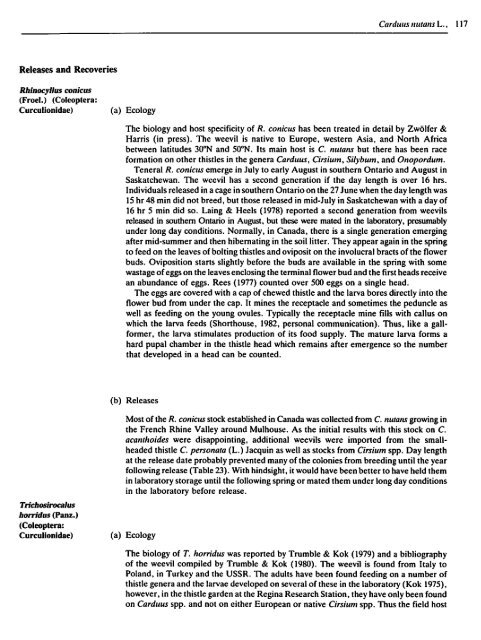pdf, 57.71Mb - Entomological Society of Canada
pdf, 57.71Mb - Entomological Society of Canada
pdf, 57.71Mb - Entomological Society of Canada
Create successful ePaper yourself
Turn your PDF publications into a flip-book with our unique Google optimized e-Paper software.
Releases and Recoveries<br />
Rhinocynus conicus<br />
(Froel.) (Coleoptera:<br />
Curculionidae) (a) Ecology<br />
Trichosirocalus<br />
horridus (panz.)<br />
(Coleoptera:<br />
Curculionidae)<br />
Carduus IIutans L., 117<br />
The biology and host specificity <strong>of</strong> R. conicus has been treated in detail by Zw61fer &<br />
Harris (in press). The weevil is native to Europe, western Asia, and North Africa<br />
between latitudes 30 0<br />
N and SooN. Its main host is C. nutans but there has been race<br />
formation on other thistles in the genera Carduus, Cirsium, Silybum, and Onopordum.<br />
Teneral R. conicus emerge in July to early August in southern Ontario and August in<br />
Saskatchewan. The weevil has a second generation if the day length is over 16 hrs.<br />
Individuals released in a cage in southern Ontario on the 27 June when the day length was<br />
15 hr 48 min did not breed, but those released in mid-July in Saskatchewan with a day <strong>of</strong><br />
16 hr 5 min did so. Laing & Heels (1978) reported a second generation from weevils<br />
released in southern Ontario in August, but these were mated in the laboratory. presumably<br />
under long day conditions. Normally, in <strong>Canada</strong>, there is a single generation emerging<br />
after mid-summer and then hibernating in the soil litter. They appear again in the spring<br />
to feed on the leaves <strong>of</strong> bolting thistles and oviposit on the involucral bracts <strong>of</strong> the flower<br />
buds. Oviposition starts slightly before the buds are available in the spring with some<br />
wastage <strong>of</strong> eggs on the leaves enclosing the terminal flower bud and the first heads receive<br />
an abundance <strong>of</strong> eggs. Rees (1977) counted over 500 eggs on a single head.<br />
The eggs are covered with a cap <strong>of</strong> chewed thistle and the larva bores directly into the<br />
flower bud from under the cap. It mines the receptacle and sometimes the peduncle as<br />
well as feeding on the young ovules. Typically the receptacle mine fills with callus on<br />
which the larva feeds (Shorthouse, 1982, personal communication). Thus, like a gallformer,<br />
the larva stimulates production <strong>of</strong> its food supply. The mature larva forms a<br />
hard pupal chamber in the thistle head which remains after emergence so the number<br />
that developed in a head can be counted.<br />
(b) Releases<br />
Most <strong>of</strong> the R. conicus stock established in <strong>Canada</strong> was collected from C. nwans growing in<br />
the French Rhine Valley around Mulhouse. As the initial results with this stock on C.<br />
acanthoides were disappointing, additional weevils were imported from the smallheaded<br />
thistle C. personata (L.) Jacquin as well as stocks from Cirsium spp. Day length<br />
at the release date probably prevented many <strong>of</strong> the colonies from breeding until the year<br />
following release (Table 23). With hindsight, it would have been better to have held them<br />
in laboratory storage until the following spring or mated them under long day conditions<br />
in the laboratory before release.<br />
(a) Ecology<br />
The biology <strong>of</strong> T. horridus was reported by Trumble & Kok (1979) and a bibliography<br />
<strong>of</strong> the weevil compiled by Trumble & Kok (1980). The weevil is found from Italy to<br />
Poland, in Turkey and the USSR. The adults have been found feeding on a number <strong>of</strong><br />
thistle genera and the larvae developed on several <strong>of</strong> these in the laboratory (Kok 1975),<br />
however, in the thistle garden at the Regina Research Station, they have only been found<br />
on Carduus spp. and not on either European or native Cirsium spp. Thus the field host
















